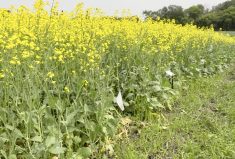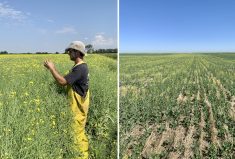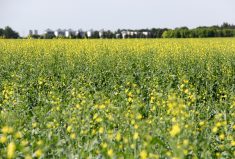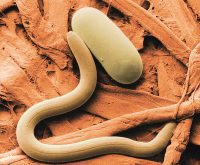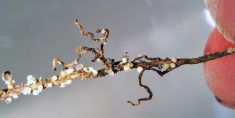Soybean cyst nematodes haven’t been found in Manitoba yet.
That’s the good news.
The bad news is it’s only a matter of time until they are, says University of Manitoba soil scientist Mario Tenuta. But early detection will help farmers manage it.
The search for the small, soil-borne, worm-like parasites that can dramatically reduce soybean yields has been on in this province since 2013. They might already be here.
Farmers can learn more about soybean cyst nematodes, including what they look like and how to search for them, July 22 at the Soybean Management & Research Transfer (SMART) Day at the University of Manitoba’s Ian N. Morrison Research Farm at Carman. Attendance is free but farmers must register by July 17 (register by clicking here).
Read Also

Journal pulls long-cited glyphosate study for ethics violations
The journal Regulatory Toxicology and Pharmacology has retracted a 2000 Monsanto-linked glyphosate review, drawing new scrutiny as Bayer faces mounting legal pressure.
Soil samples taken last fall from Manitoba fields contained some nematodes but DNA testing just completed last week revealed they are not the destructive soybean cyst nematode, Tenuta said in an interview July 10.
“We are continuing with more sampling this year,” he said.
“We are targeting fields that have had soybeans in them more than three years.”
Most soil nematodes are good, helping in the nutrient cycle, among other things, Tenuta said
Soybean cyst nematodes, which are harmful to soybeans, are close by in Minnesota and North Dakota. Meanwhile, Manitoba with 1.3 million acres of soybeans and growing is a perfect place for the pest to thrive.
Just as with clubroot in canola, detecting soybean cyst nematodes early is key to managing them. The trouble is when their numbers are low, symptoms are hard to spot and can be easily confused with other root-related problems, including root rot and water-saturated soils.
“Often by the time they are found in a field populations have built up and are causing 20 to 30 per cent loss in yield,” Tenuta said. “This is why we are being fairly aggressive in our outreach to growers for learning about soybean cyst nematodes because we want to find the nematodes before they cause 20 or 30 per cent yield losses.”
Symptoms to watch for include patches of smaller plants, chlorosis and reduced yields.
“It’s a challenge to diagnose,” Tenuta said. “A trained person can dig the roots and that’s what we want to show people July 22 to see what they would look like and how to do it.”
Once soybean cyst nematodes have been found in a field they can be managed through crop rotation, growing resistant varieties, and in the near future, applying nematicides, he said.
Other plants, including edible beans, can serve as hosts as can certain weeds, including shepherd’s purse. Resistant varieties can also break down over time, Tenuta added.
“We may have to use a combination of rotation, resistant varieties and nematicides,” he said.
As soybean cyst nematodes’ populations build in a field the more potential for yield losses. However, the damage can vary with soil type and weather conditions.
“Because they affect the function of the root system in years that are dry the disease symptoms and yield loss will manifest more,” Tenuta said. “If you’re on a soil that is much more well drained or has lower water-holding capacity such as lighter soils the disease will show up in those fields earlier. With the same number of nematodes in a wet year or in a clay field you might not see a measurable yield reduction. But the pest could be building in numbers and then in a year that is dry you could have severe losses.”
Soybean cyst nematodes, like clubroot in canola, move in the soil. They can move on soil in the air and water, on animals, including the feet of migratory birds, on vehicles and farm equipment.
“Field equipment with soil on it is really, really an efficient way to move soybean cyst nematodes around,” Tenuta said. “Bringing in equipment from the United States that hasn’t been washed and sanitized is not a good idea. And in Manitoba it could move between fields that way. I understand the work it would take to clean equipment between fields in the busy seasons, but we do have to keep this in mind.”
The SMART Day, which runs from 9 a.m. until 4 p.m., also includes trials on residue management, strip tillage, controlling Roundup Ready volunteer canola, phosphorus fertilization and inoculation strategies.




